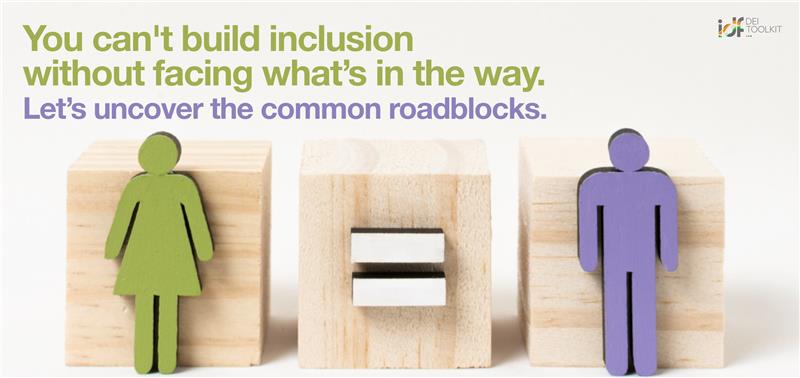Creating a truly inclusive workplace goes beyond writing a diversity statement or hosting annual events. It demands a conscious, continuous effort to identify, understand, and address the barriers that prevent individuals from feeling valued, respected, and empowered to contribute. These barriers may be visible or invisible, deeply embedded in workplace culture, systems, and even unspoken norms. Recognizing them is the first step toward creating an environment where inclusion is not a goal on paper but a lived reality.

Why Identifying Barriers to Inclusion is Critical for Progress
When barriers to inclusion go unaddressed, they silently shape employee experiences. They influence who feels comfortable speaking up, who has access to growth opportunities, and even who chooses to remain in the organization. These barriers can impact:
- Engagement — Employees who feel excluded are less likely to participate actively in discussions, decision-making, or innovation.
- Retention — A lack of inclusion is one of the top reasons people from underrepresented groups leave organizations.
- Reputation — In an age where workplace culture is publicly discussed and reviewed, exclusionary environments risk damaging brand perception.
An inclusive workplace not only attracts diverse talent but also ensures that this talent thrives. This means identifying barriers to inclusion is not just a moral imperative—it’s a business priority.
Common Workplace Barriers to Inclusion
While every organization’s challenges are unique, certain patterns appear consistently across industries and geographies. Understanding these helps leaders and DEI teams recognize issues before they deepen.
1. Structural Barriers
These are embedded in the systems, policies, and processes of an organization. Examples include:
- Inequitable hiring practices that favor certain demographics or educational backgrounds.
- Limited accessibility in physical and digital spaces for persons with disabilities.
- Rigid work schedules that do not accommodate caregiving responsibilities or different working styles.
Structural barriers are often the hardest to detect because they may have been part of “how things have always been done” for years.
2. Cultural Barriers
Workplace culture—the shared norms, values, and unwritten rules—can either invite or exclude participation. These barriers include:
- Unspoken expectations that certain communication styles are “professional” while others are dismissed.
- Social exclusion in informal settings, where networks and opportunities are formed.
- Tolerance of microaggressions or subtle discriminatory behavior.
Cultural barriers are often reinforced unintentionally but can deeply impact belonging.
3. Attitudinal Barriers
Sometimes, exclusion stems from personal biases or misconceptions held by individuals at all levels. These can include:
- Stereotyping certain groups as less capable or less committed.
- Resistance to change from employees or leaders who feel inclusion initiatives are unnecessary.
- Tokenism—including individuals from underrepresented groups in visible roles without genuinely valuing their contributions.
Attitudinal barriers are highly damaging because they erode trust and make inclusive policies ineffective in practice.
Identifying Barriers to Inclusion Through Data and Dialogue
The process of identifying barriers to inclusion must be deliberate and evidence-based. Guesswork or surface-level assumptions are not enough. Organizations can begin by:
1. Conducting Inclusion Audits
An inclusion audit involves a detailed review of organizational policies, hiring practices, pay equity, career advancement opportunities, and employee resource allocation. It’s a way to uncover whether the systems in place unintentionally disadvantage certain groups.
2. Gathering Employee Feedback
Surveys, focus groups, and one-on-one conversations provide a direct window into lived experiences. Anonymous feedback channels can be particularly effective for surfacing issues that employees may hesitate to raise openly.
3. Measuring Representation Beyond Hiring
Diversity at the entry level is a start, but organizations must track representation across leadership, project ownership, and decision-making spaces. If certain groups are missing in these areas, it’s a clear signal of barriers in progression.
4. Analysing Exit Interviews
Employees who leave often provide candid insights into cultural and structural challenges. Patterns in these conversations can highlight long-standing inclusion issues.
Addressing the Barriers Once Identified
Recognizing the barriers is only the beginning. The next step is taking consistent, transparent action to address them. Effective strategies include:
- Revisiting and rewriting policies to remove inequities and create flexibility where possible.
- Training leaders and managers to recognize unconscious bias and build inclusive teams.
- Implementing mentorship and sponsorship programs to support career growth for underrepresented employees.
- Creating accountability mechanisms—leaders should have measurable inclusion goals tied to performance reviews.
Importantly, addressing barriers to inclusion is not a one-time project but an ongoing commitment. Inclusion must be continuously reviewed and refined as the organization grows and changes.
Moving from Awareness to Action
Identifying barriers to inclusion is an act of courage for an organization—it requires acknowledging that existing systems may be failing some employees. But awareness without action risks reinforcing the very inequalities we aim to dismantle.
Leaders must be prepared to listen without defensiveness, communicate openly about findings, and demonstrate through policy and practice that inclusion is a shared responsibility. Employees, in turn, must be empowered to participate in creating and sustaining an inclusive environment.
Final Thoughts
Barriers to inclusion often exist in places we least expect—hidden in traditions, policies, or attitudes that have gone unquestioned for too long. The journey to dismantle them begins with a commitment to see them clearly and a willingness to change what no longer serves the organization or its people.
The India Diversity Forum’s DEI Toolkit offers organizations practical resources, assessments, and strategies to uncover and address these barriers effectively. From conducting inclusion audits to shaping equitable policies, the Toolkit is designed to turn insight into action and make inclusion a tangible reality.
Discover how the DEI Toolkit can help your organization move beyond awareness and take meaningful steps toward a truly inclusive workplace. Start using it today to identify and break down the barriers holding your workforce back.


